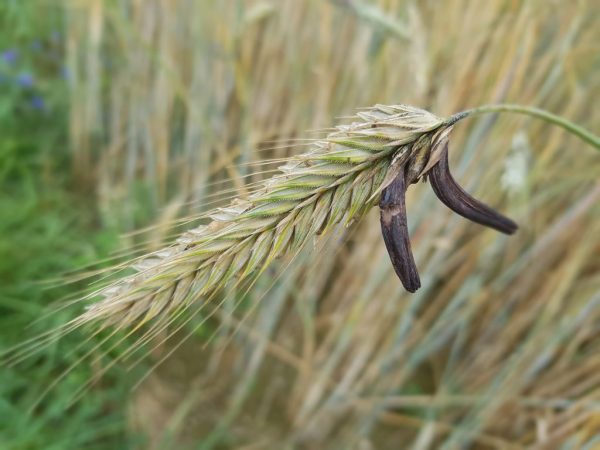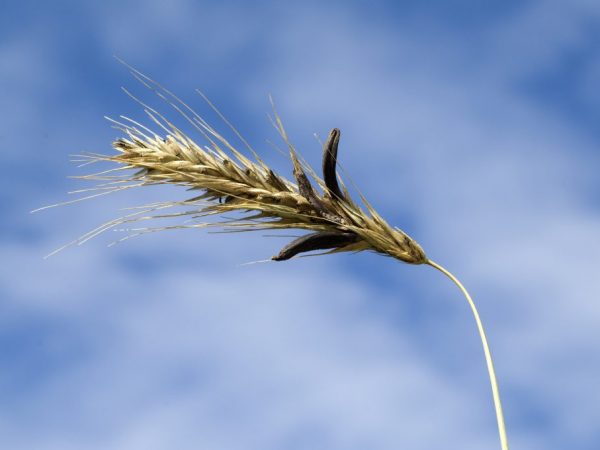Ergot fungus parasitizing on cereals
The ergot mushroom belongs to the Ergot family, whose representatives are parasitic on cereals.

Ergot mushroom parasitizing on cereals
Botanical characteristic
Ripe ergot looks like a dark purple, almost black horn, located in the ear of cereal in place of the grain, exceeding it in length. Because of the triangular furrowed shape, this parasite was nicknamed "wolf's tooth", and because of the toxic effect on the body - "poisonous grain." This species is also called "uterine horns".
The name of the mushroom comes from the Old Russian word meaning "abundance", "harvest".
More common among plantings of rye and wheat. It is poisonous. Refers to ascomycetes - marsupials, the spores of which ripen in special formations - asci, or bags. The parasite is mistakenly referred to as reducers, because the fungus is not a saprotroph and does not destroy the remains of living beings. By its botanical nature, the parasitic fungus belongs to heterotrophs, is a consumer, and consumes ready-made organic substances, taking them from the host plant.
It spreads quickly. Up to 150 kg of ergot horns are harvested from 1 hectare of the planting area of cereals.
Development cycle
The initially reddish mycelium forms in spring. It looks like a leg with a head, on top are the fruiting bodies - perithecia. As a result, cells (zygotes) are formed. With the onset of summer, ripe ascospores are carried by wind currents or by means of insects and, when they hit the pistils of flowering cereals, grow into the ovary, forming a fungal mycelium instead of a grain.
The spread of ergot among cereals is enhanced at the stage of formation and release of sweet honeydew, which attracts insects that carry fungal conidia to other plants.
After the depletion of the cereal ovary, a plexus of filaments of fungal mycelium (sclerotia) is formed, which resembles a long horn.
Irina Selyutina (Biologist):
The most common parasitic species of the genus Ergot is the purpurea ergot. Its black-purple sclerotia (horns) wintering in the soil consist of a core, which is covered with a special formation of melanized (colored) thick-walled cells - the bark. The composition of sclerotia includes:
- about 3-4% sugars (glucose, trehalose, etc.);
- up to 1% polyhydric alcohols;
- a lot of lipids.
Germination of sclerotia is activated by exposure to sufficiently low temperatures (-3 ... + 5 ℃) for a long time. However, germination occurs only when the temperature is set at least + 10 ... + 20 ℃. This is how strict coordination of the life cycles of the parasite and the host is achieved: the ejection of ascospores occurs during the period of mass flowering of cereals.
In the process of cereal maturation, the horn falls to the ground, remaining in the soil layer throughout the winter and forming a new mycelium in the spring.
Geography of distribution
Ergot are found in the temperate latitudes of the Northern Hemisphere, there are some species that live on the territory of the North African, South American and Australian continents. The exception is the northern regions of the Scandinavian Peninsula.
In Russia, it is found everywhere except for the Far North of the European part of the Russian Federation. In some areas, ergot is grown deliberately for use in pharmacology.
Harm to health

Eating contaminated cereals can cause food poisoning
Ergot sclerotium contains in the chemical composition a significant proportion of nitrogen-containing organic compounds - alkaloids, including the indole alkaloid ergotinine, which has special toxic properties for human health, which causes poisoning. When using it:
- cramps and spasms appear;
- mental disorders are recorded;
- the motor function of the visual organ is disturbed, after a certain time, after ergotinine enters the body, the pathology of the eye lens (cataract) develops.
A large dose is fatal.
Clavicepsotoxicosis, or ergotism, is a disease that occurs when ergot alkaloids enter the human body, due to their effect on smooth muscles, blood vessels and the nervous system. This disease is known to physicians in the following forms:
- gangrenous ("Antonov fire");
- convulsive ("angry cramps").
Practical use
In pharmacology, sclerotia is used, collected from ergot growing on rye. In small doses, poisonous ergot, containing ergometrine and ergotamine, is applicable as a medicine for the following diseases and conditions of the body:
- against a hormonal tumor of the pituitary gland (prolactinoma);
- for the treatment of disorders of the nervous system;
- when overexcited;
- with increased heart rate;
- to reduce migraine attacks;
- to stop uterine bleeding.
From lysergic acid, which is a derivative of ergot ergot alkaloids, chemists have obtained a semi-synthetic psychoactive drug lysergamide, which has a hallucinogenic effect on humans.
Conclusion
The ergot parasite fungus belongs to the Ergot family. It is one of the consumers, it parasitizes on cereals, feeding on organic matter from the host plant on which it parasitizes. His body contains toxins that can cause serious poisoning. Ergot is used for medicinal purposes in a number of cases, however, if the dosage is exceeded, it can harm health and even death.



